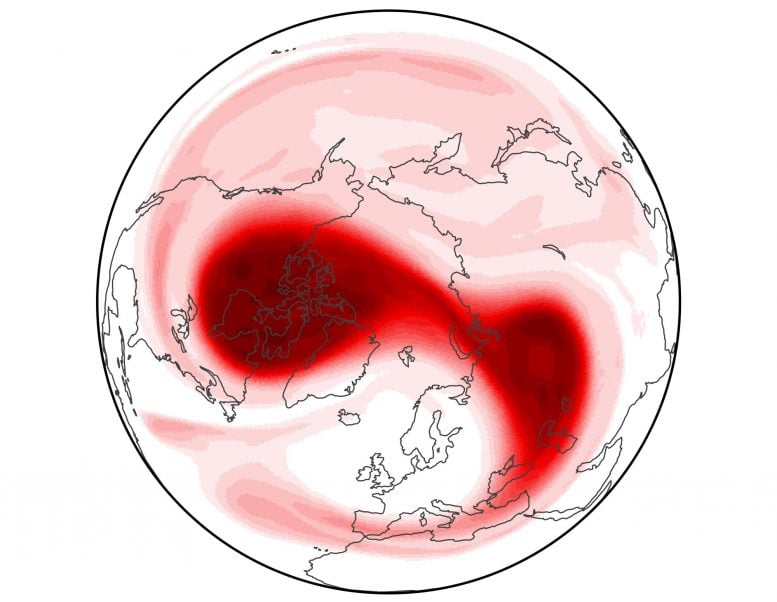
The stratospheric potential vorticity field on February 10, 2018. The Stratospheric Polar Vortex is about to split in two, and the weakening of the vortex was followed around two weeks later by a severe cold air outbreak over Europe known as the Beast from the East. Data from ERA-Interim reanalysis (Dee et al., 2011). Credit: University of Bristol
A new study led by researchers at the Universities of Bristol, Exeter, and Bath helps to shed light on the winter weather we may soon have in store following a dramatic meteorological event currently unfolding high above the North Pole.
Weather forecasting models were predicting with increasing confidence that a sudden stratospheric warming (SSW) event would take place on January 5, 2021, and indeed, experts confirmed that it is underway.
The stratosphere is the layer of the atmosphere from around 10-50km (6-31mi) above the earth’s surface. SSW events are some of the most extreme of atmospheric phenomena and can see polar stratospheric temperature increase by up to 50°C (122 °F) over the course of a few days. Such events can bring very cold weather, which often result in snowstorms.
The infamous 2018 “Beast from the East” is a stark reminder of what an SSW can bring. The disturbance in the stratosphere can be transmitted downward and if this continues to the earth’s surface, there can be a shift in the jet stream, leading to unusually cold weather across Europe and Northern Asia. It can take a number of weeks for the signal to reach the surface, or the process may only take a few days.
The study, published in the Journal of Geophysical Research and funded by the Natural Environment Research Council (NERC), involved the analysis of 40 observed SSW events that occurred over the last 60 years. Researchers developed a novel method for tracking the signal of an SSW downward from its onset in the stratosphere to the surface.
Findings in the paper, “Tracking the stratosphere-to-surface impact of Sudden Stratospheric Warmings” suggest split events tend to be associated with colder weather over north west Europe and Siberia.
Lead author of the study, Dr. Richard Hall, said there was an increased chance of extreme cold, and potentially snow, over the next week or two.:
“While an extreme cold weather event is not a certainty, around two-thirds of SSWs have a significant impact on surface weather. What’s more, today’s SSW is potentially the most dangerous kind, where the polar vortex splits into two smaller ‘child’ vortices.”
“The extreme cold weather that these polar vortex breakdowns bring is a stark reminder of how suddenly our weather can flip. Even with climate change warming our planet, these events will still occur, meaning we must be adaptable to an ever more extreme range of temperatures,” said Dann Mitchell, Associate Professor of Atmospheric Science at the University of Bristol and co-author of the study.
“Our study quantifies for the first time the probabilities of when we might expect extreme surface weather following a sudden stratospheric warming (SSW) event. These vary widely, but importantly the impacts appear faster and stronger following events in which the stratospheric polar vortex splits in two, as is predicted in the currently unfolding event. Despite this advance, many questions remain as to the mechanisms causing these dramatic events, and how they can influence the surface, and so this is an exciting and important area for future research,” said Dr. William Seviour, senior lecturer at the Department of Mathematics and Global Systems Institute, University of Exeter, and co-author of the study.
Reference: “Tracking the stratosphere‐to‐surface impact of Sudden Stratospheric Warmings” by Richard J. Hall, Daniel M. Mitchell, William J.M Seviour and Corwin J. Wright, 25 December 2020, Journal of Geophysical Research.
DOI: 10.1029/2020JD033881


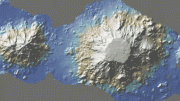

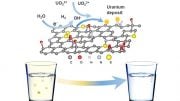

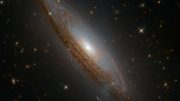
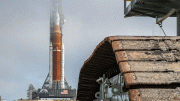
Searching in vain for thermal equilibrium I think. Rising geothermal potential is one method of achieving this. Thus we get more SSW.
Of course, it has nothing to do about the huge planets we have coming in from behind us. Get out of your lightzone, look N-NE after sunset. See with your own eyes, huge dark areas, blocking the stars. Look closely, you will see circumference.
Something easier to point out, look at your moon when it first comes up. Take a pic every two hours. Compare your pics and the end of the night. It appears the moon is rolling but, it’s us. Here is an example, https://youtu.be/FIWWzk6K8uA
Not only do you see it with the moon, also the sun and elliptical planets.
Example,https://youtu.be/lOZZfboD0Jg
Maybe the gov should stop with the “Stratospheric Aerosol Injections”
“Even with climate change warming our planet, these events will still occur”…
I would have liked Mr Mitchell to give us a few sentences explaining how he proposed to tie this phenomenon to “Climate Change”, and how he proposed to test his theory. I suspect he cannot.
I also suspect that these days any researcher wanting funding has to include some reference to “Climate Change”, even when it seems likely that the subject under discussion is no more than some aspect of weather, so perhaps we should not be too harsh. Blaming something on “Climate Change” is the path to a weekly pay cheque, publications and promotion. “Weather” is not.